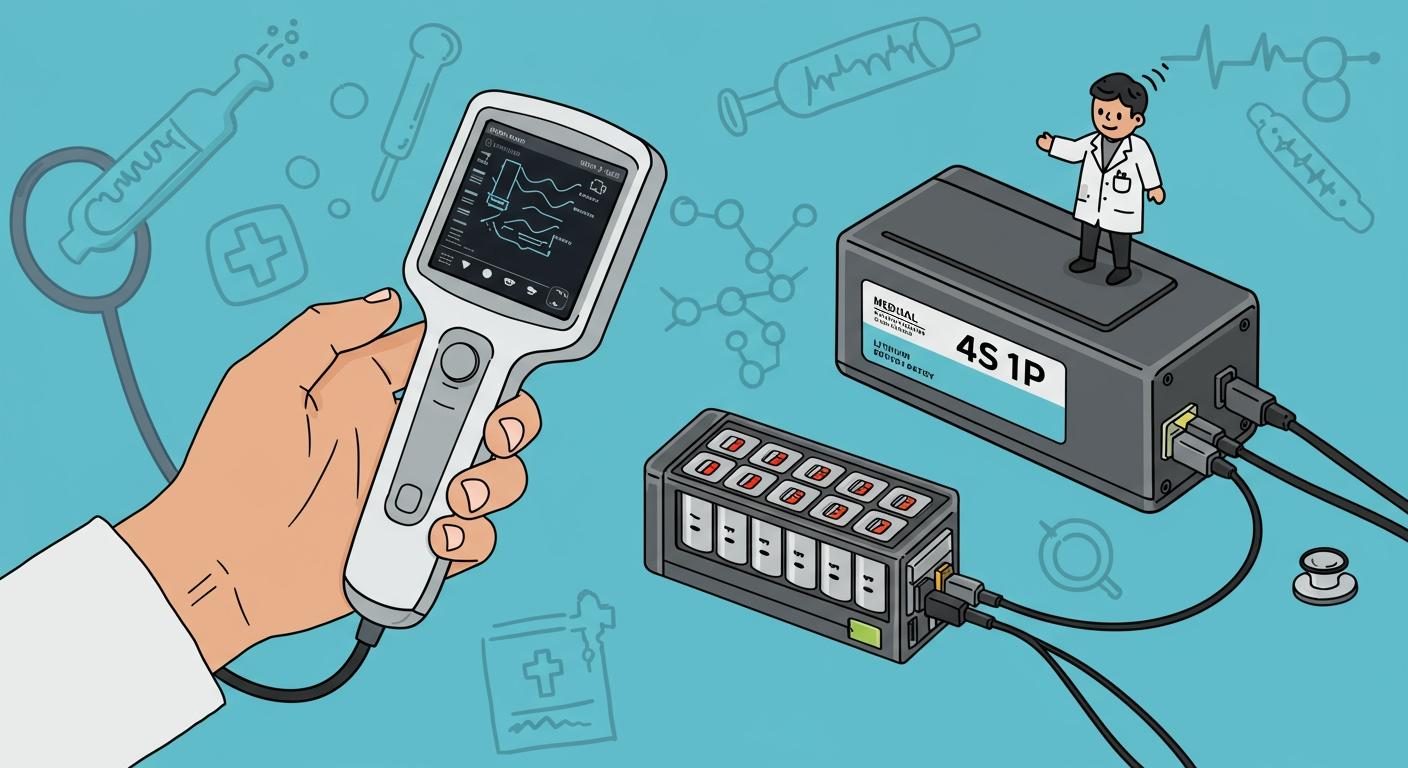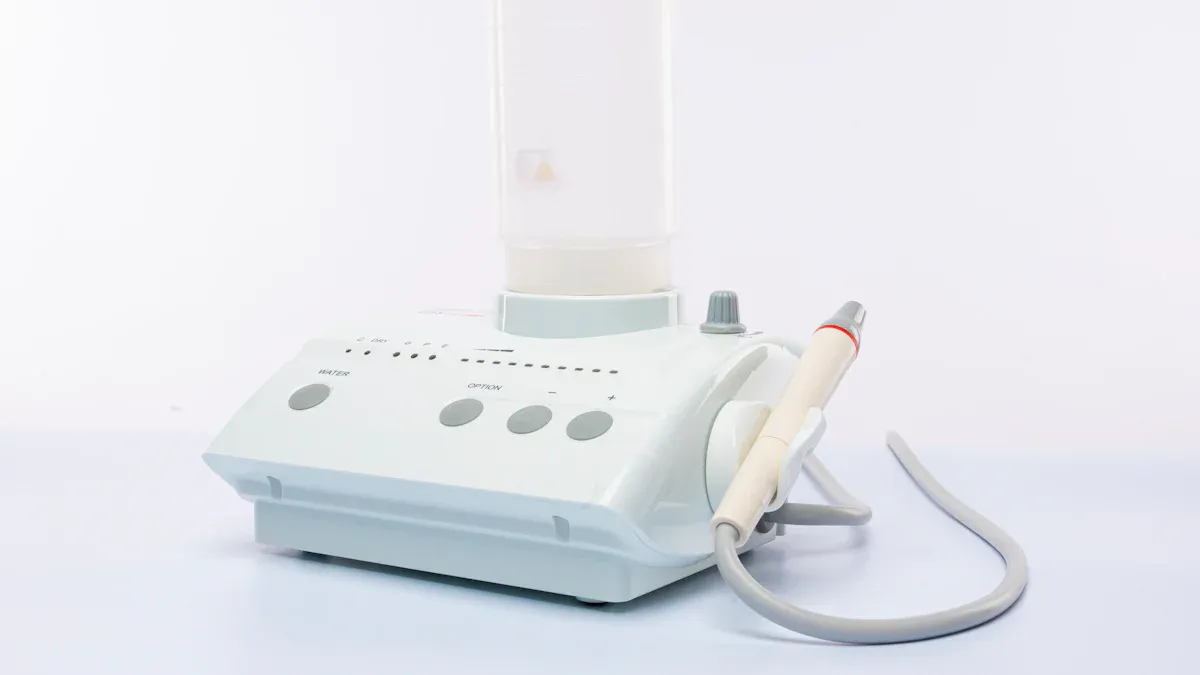
Battery technology shapes how you use handheld ultrasound in medical settings. You need power sources that deliver consistent performance. 4s1p 18650 lithium batteries give you high energy density, a lightweight design, and reliable operation. Many medical devices now rely on lithium batteries. In fact, as of 2024, lithium-ion batteries hold a market share of 50.73% in the medical battery market.
You benefit from:
Longer device runtime
Easier transport for point-of-care use
Dependable power for accurate imaging
Key Takeaways
4S1P lithium batteries provide high energy density, allowing handheld ultrasound devices to run longer without frequent recharging.
These batteries are lightweight, reducing device weight by 25%, which enhances portability and ease of use in medical settings.
Safety features in 4S1P lithium batteries protect users and patients, ensuring compliance with strict medical standards.
Efficient charging and discharging practices can extend the lifespan of lithium batteries, reducing maintenance costs for healthcare providers.
Choosing certified lithium batteries ensures reliability and safety, helping to protect both patients and healthcare staff.
Part 1: 4S1P Lithium Batteries in Handheld Ultrasound

1.1 Energy Density and Performance
You need reliable imaging when you use handheld ultrasound in clinical settings. 4s1p 18650 lithium batteries deliver high energy density, reaching up to 270 Wh/kg. This means your device can run longer and provide consistent power output for accurate scans. High energy density allows you to use medical portable ultrasound devices for extended periods without frequent recharging. You can trust the performance of lithium batteries to support demanding imaging tasks, even during busy shifts.
Lithium-ion batteries also help maintain stable voltage throughout the battery cycle. This stability ensures your handheld ultrasound does not lose image quality as the battery discharges. You get clear, dependable results every time you use your device. High battery capacity means you can scan more patients before needing to recharge.
1.2 Lightweight and Portability
You want portable ultrasound devices that are easy to carry and use at the point of care. 4s1p lithium batteries make this possible by reducing device weight and increasing battery life. The integration of lithium batteries leads to a 25% decrease in device weight, making it easier for you to move between patient rooms or different departments.
Here is how 4s1p lithium batteries improve portability:
Improvement Aspect | Description |
|---|---|
Weight Reduction | Device weight decreased by 25%, enhancing portability for users. |
Battery Life Increase | Battery lifespan extended from 300 to over 1500 cycles, allowing longer use between charges. |
Operational Reliability | Improved reliability means devices can operate longer without needing a recharge. |
You can rely on lithium-ion batteries to deliver long-lasting power. This means fewer interruptions and more efficient workflows. When you use handheld ultrasound, you benefit from both lightweight design and extended operational time.
1.3 Safety Features
Safety is critical in medical environments. 4s1p lithium batteries include advanced safety features to protect both you and your patients. These batteries have built-in protection against overcharging, overheating, and short circuits. You can use your device with confidence, knowing that lithium technology meets strict safety standards.
Medical devices must comply with important safety certifications. The following table shows the main certifications required for lithium batteries in healthcare:
Certification/Standard | Description |
|---|---|
FDA General Safety and Performance Requirements (US) | Must meet IEC 62133, UL 2054, ISO 13485, and IEC 60601-1; biocompatibility required; safety features for use near patients; must be authenticated and traceable. |
European Medical Device Regulation (EU) | Must comply with MDR essential safety and performance requirements; biocompatibility required; must adhere to ISO 13485 quality management system; must be tested and evaluated for compliance. |
You can see that lithium-ion batteries in handheld ultrasound devices must pass rigorous testing. These standards ensure your devices remain safe and reliable during daily use. When you choose lithium batteries, you help protect both patients and healthcare staff.
Tip: Always check that your battery supplier provides documentation for all required certifications. This step helps you avoid compliance issues and ensures patient safety.
Part 2: Technical Specs of Lithium Batteries
2.1 Voltage and Capacity
You need to understand the voltage and capacity of lithium batteries when choosing power solutions for handheld ultrasound. These specifications determine how long your devices run and how stable the performance remains. The 4S1P 18650 lithium battery pack configuration provides a reliable voltage range and high capacity, which supports consistent power output for medical imaging.
Description | Voltage (Volts) |
|---|---|
Charge Voltage | 16.8 |
Nominal Voltage | 14.8/14.4 |
Discharge Cut-off Voltage | 10.0 |
The standard capacity for 4S1P lithium batteries in medical applications is 3350 mAh. This capacity allows you to scan multiple patients before needing to recharge your device.
Configuration | Capacity (mAh) |
|---|---|
4S1P | 3350 |
2.2 Charging and Discharging Efficiency
Efficient charging and discharging help you maximize the lifespan of lithium-ion batteries. You benefit from fast charging times and stable discharge rates, which means your handheld ultrasound stays ready for use. Lithium batteries maintain high efficiency, so you experience less downtime and more reliable operation. You should avoid deep discharges and extreme temperatures to preserve battery health. Proper charging practices extend the operational life of your medical devices and reduce maintenance costs.
Tip: Use chargers designed for lithium-ion batteries to ensure safe and efficient charging. This practice helps prevent overheating and prolongs battery life.
2.3 Lifespan and Durability
You want batteries that last through many cycles and maintain performance. The lifespan of a 4S1P lithium battery in medical devices typically ranges from hundreds to over a thousand charge cycles. Battery quality, chemistry, and usage patterns all affect durability. If you manage your batteries well, such as by avoiding full discharges and keeping them at moderate temperatures, you can extend their lifespan even further.
To help you compare different lithium battery chemistries, here is a table showing platform voltage, energy density, and cycle life:
Chemistry | Platform Voltage (V) | Energy Density (Wh/kg) | Cycle Life (cycles) |
|---|---|---|---|
LCO | 3.7 | 150-200 | 500-1000 |
NMC | 3.7 | 200-250 | 1000-2000 |
LiFePO4 | 3.2 | 90-160 | 2000-5000 |
LMO | 3.7 | 100-150 | 300-700 |
LTO | 2.4 | 70-110 | 7000-20000 |
Solid-State | 3.7 | 250-350 | 1000-5000 |
Lithium Metal | 3.7 | 350-500 | 500-1000 |
You can see that lithium-ion batteries offer a strong balance of energy density and cycle life for handheld ultrasound and other medical devices. This makes them a preferred choice for reliable and long-lasting performance.
Part 3: Comparing Battery Solutions

3.1 4S1P vs Other Lithium Configurations
When you compare 4s1p 18650 lithium batteries to other lithium configurations, you see clear differences in cost, reliability, and lifespan. The 4s1p setup offers a strong balance between high energy density and long cycle life, which is essential for handheld ultrasound and other medical portable ultrasound devices. You benefit from fewer replacements and lower maintenance costs over time.
Battery Type | Initial Cost | Total Cost Over 10 Years | Cycle Life (cycles) |
|---|---|---|---|
Lithium-ion (LiFePO4, NMC) | High | Low | 2000–5000 |
Alkaline | Low | High | 1 |
Non-rechargeable Lithium | Moderate | High | 1 |
Longer lifespan means you replace batteries less often.
Fewer replacements lower costs for healthcare systems.
Reduced replacements also decrease the risk of clinical complications.
You get a better return on investment with lithium-ion batteries because they last longer and require less labor to maintain.
3.2 Lithium Batteries vs Other Chemistries
You need to know how lithium batteries compare to nickel-metal hydride and lead-acid batteries in portable ultrasound devices. Lithium-ion batteries deliver the highest energy densities and longest cycle life. They also weigh less and charge more efficiently. However, you must use a battery management system to prevent hazards.
Battery Type | Advantages | Disadvantages |
|---|---|---|
Lithium-ion | Highest energy density, long cycle life, low weight | High cost-per-watt, risk of thermal runaway |
High charge efficiency, stable at high temperatures | Needs battery management system, sensitive to temps | |
Nickel-metal hydride | More energy than lead-acid, high power density | Lower cycle life, less energy density |
Lead-acid | Cost-effective, widely available | Heavy, low energy density, short cycle life |
You see that lithium batteries give you the best performance for handheld ultrasound, but you must manage them carefully for safety.
3.3 Regulatory Compliance
You must follow strict standards when using lithium battery packs in medical devices. These standards help you ensure safety and reliability for both patients and staff.
Standard | Description |
|---|---|
IEC 62133-2:2017 | Safety standard for lithium batteries |
UN38.3 | Transport safety testing standard |
High-quality lithium-ion batteries with advanced safety features are essential for handheld medical devices.
Regular inspections and timely replacements improve patient safety.
Compliance with these standards is crucial for your medical device approval.
Note: Batteries in medical devices must be removable and replaceable by end-users, except for certain specialized applications.
Part 4: Practical Considerations for Manufacturers
4.1 Supplier Selection
Choosing the right supplier for lithium battery packs is essential for your handheld ultrasound and other portable ultrasound devices. You need to ensure that the batteries you source meet strict safety and reliability standards. When evaluating suppliers, look for those who follow recognized quality management systems such as ISO 9001 and ISO 13485. These certifications show that the supplier maintains high standards for manufacturing and quality control.
You should also check that your supplier performs rigorous testing and validation of lithium-ion batteries under different conditions. This process helps confirm that the batteries will perform reliably in your devices. A strong complaint management system allows you to track and resolve any issues after the batteries reach the market. Environmental compliance is another key factor, especially if you serve industries like medical, robotics, or security systems.
Key supplier selection practices:
Ensure safety and reliability of lithium-ion batteries
Verify supplier qualifications (ISO 9001, ISO 13485)
Require thorough testing and validation
Implement complaint management systems
Confirm environmental compliance
Tip: Always request documentation for certifications and test results before making a purchase.
4.2 Charger Compatibility
You need to match your chargers to the specific requirements of your lithium batteries. Using the correct charger helps maintain battery lifespan and ensures safe operation in medical and industrial devices. For 4S1P 18650 lithium battery packs, the recommended charger specifications are:
Specification | Value |
|---|---|
Charging Voltage | 16.8V |
Charging Current | 640mA |
Discharging Current | 640mA |
Maximum Discharging Current | 2600mA |
Charging Temperature | 0~45℃ |
Discharging Temperature | -20~60℃ |
Selecting a charger with automatic cutoff and temperature monitoring features, such as a NMC-compatible charger, can further improve safety:
Charger Type | Voltage Requirement | Safety Feature |
|---|---|---|
NMC-compatible charger | 16.8V | Automatic cutoff, temperature monitoring |
Note: Using the wrong charger can shorten battery life and increase safety risks. Always follow manufacturer guidelines for charging lithium-ion batteries.
4.3 Customization Options
You may need custom lithium battery solutions to fit the unique requirements of your handheld ultrasound or other portable ultrasound devices. Manufacturers can offer a range of customization options to help you achieve the best performance and branding for your products. These options are especially important for industries like medical, consumer electronics, and industrial applications.
Customization Option | Description |
|---|---|
Custom Label | Tailored labeling for branding |
Custom Firmware | Specific software adjustments |
Performance Options | Adjustments to meet performance needs |
You can request custom labels to match your brand, firmware adjustments for device integration, or performance tweaks to meet demanding operational needs. This flexibility helps you scale your product line and address different application scenarios.
Callout: Customization ensures your lithium batteries deliver optimal performance and reliability for every device and industry you serve.
FAQ
What does 4S1P mean in lithium battery packs?
You see “4S1P” to describe a battery pack with four cells in series and one in parallel. This setup gives you higher voltage and stable performance, which suits handheld ultrasound and other portable medical devices.
How do lithium battery chemistries affect device performance?
You choose chemistries like NMC, LiFePO4, or LCO based on your needs. NMC offers high energy density and long cycle life. LiFePO4 gives you more cycles and better safety. LCO provides stable voltage for imaging.
Why should you use certified lithium batteries in medical devices?
You protect patients and staff by using batteries with certifications like IEC 62133 and ISO 13485. Certified batteries meet strict safety and quality standards. You reduce risks and ensure compliance in healthcare, robotics, and security applications.
How can you extend the lifespan of your lithium battery packs?
You keep batteries at moderate temperatures and avoid deep discharges. You use chargers designed for lithium-ion packs. These practices help you get more cycles and reliable performance in your devices.
What customization options do manufacturers offer for lithium battery packs?
You request custom labels, firmware, and performance adjustments. Manufacturers tailor battery packs for your brand and application needs. You improve device integration and meet specific requirements in medical, industrial, or consumer electronics sectors.




